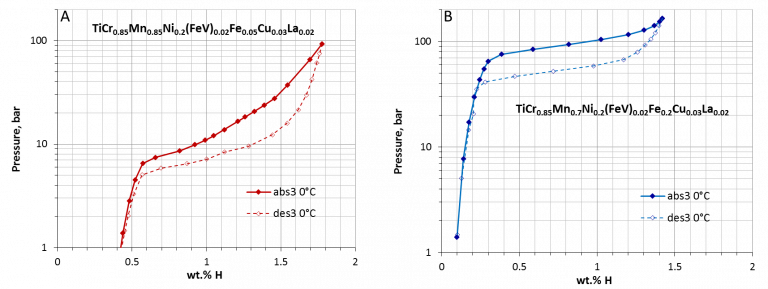
Secondment period: 17th June – 17th July 2019 within WP1 “Development and characterisation of advanced MH materials for hydrogen storage and compression”
Host: Prof. V.A. Yartys

Photo, from left to right: M.W Davids (UWC/HySA Systems), R.Denys (Hystorsys), T.Martin (UWC/HySA Systems) and V.Yartys (IFE)
Objective of Secondment:
The objective of the secondment was to prepare and study possible AB2 type metal hydride alloys that can be utilised for high-pressure compression, which in future can be incorporated into H2 refuelling stations for H2 fuelled utility vehicles. Low-pressure AB2 alloys, AB5 alloys based on La and Ce and BCC alloys were also prepared.
The preparation of all alloys were done by arc-melting method. For high-pressure alloys TiCrMn system was chosen, the target is to develop a MH alloy the can desorb H2 at 140 oC above 500 bar. For low-pressure alloy TiZrCrMn system was chosen, the alloy should have a maximum reversible H2 storage capacity between 20 and 50 oC, charge pressure 10 – 30 bar and discharge pressure 1 bar.
The list of alloys that were prepared are shown below all samples were prepared by arc-melting and annealed at 950 oC for 22 hr. PCT studies were only performed on two samples due to time limitation, samples 1 and 4 were tested at IFE and all other samples will be tested at the University of the Western Cape / HySA systems.
High Pressure Alloys:
- TiCr85Mn0.85Ni0.2(FeV)0.02Fe0.05Cu0.03La0.02
- TiCr9Mn0.9Ni0.1(FeV)0.02Fe0.05Cu0.03La0.02
- TiCr95Mn0.95(FeV)0.02Fe0.05Cu0.03La0.02
- TiCr85Mn0.7Ni0.2(FeV)0.02Fe0.2Cu0.03La0.02
- Ti82Zr0.18Cr0.88Mn0.34Ni0.2Fe0.55Cu0.03La0.02
Low Pressure Alloys:
- Ti85Zr0.15Cr0.1Mn1.34Ni0.12(FeV)0.42La0.02
- Ti85Zr0.15Mn1.42Ni0.12(FeV)0.48Ni0.12La0.02
AB5 alloys:
- La5Ce0.5Ni4.5Co0.5
- La6Ce0.4Ni5
BCC alloys:
- (FeV)75Ti0.1Cr0.075Zr0.075
- V75Ti0.1Cr0.075Zr0.075
Experimental: Hydrogen absorption-desorption measurements
- 8 g of alloy crushed in agate mortar to coarse powder (<1 mm) and immediately loaded into sample holder;
- Activation: 30 min at 90°C in dynamic vacuum (turbo-molecular pump; 10-5 mbar);
- Hydrogenation at 0°C, initial hydrogen pressure 160 bar, final pressure approx. 90 bar;
- PCT measurements at 0°C: 3rd absorption-desorption in pressure range 1 -160 bar.
Results:
From figure 1, it can be observed that sample (A) does not show a satisfactory performance for high-pressure application due to its low desorption plateau at 0 oC (6 – 18 bar), sloping plateau, large amount of H2 in solid solution and low reversible capacity 0.8 wt.% H.
To improve the sorption performance of the alloy we altered the composition, this was done by decreasing the Mn content by 0.15 at. / f.u. AB2 alloy and increasing the Fe content by 0.15 at. / f.u. AB2 alloy.
Sample (B) can be considered as a promising MH alloy for high-pressure application due to its high desorption plateau at 0 oC (50 – 60 bar), flat plateau, small hysteresis and relatively good reversible capacity 1.2 wt.% H.

Figure 1: (A) PCT ABS / DES isotherms for TiCr0.85Mn0.85Ni0.2(FeV)0.02Fe0.05Cu0.03La0.02 at 0 oC, (B) PCT ABS / DES isotherms for TiCr0.85Mn0.7Ni0.2(FeV)0.02Fe0.2Cu0.03La0.02 at 0 oC
CONCLUSIONS:
- La significantly facilitates alloy activation;
- Increased content of Fe reduces amount of H2 in solid solution;
- Increased content of Fe and simultaneous reduction of Mn increases the plateau pressure and increases the H2 storage reversible capacity of the alloy.

